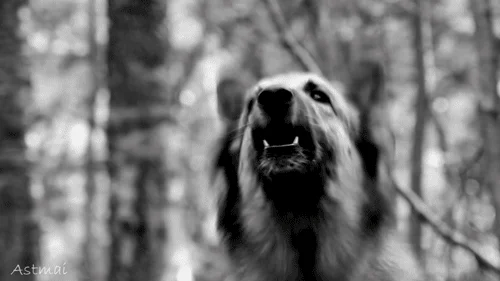How do we know to be scared?
Sometimes, others show us what should be feared. A parent acts scared, and we might take that on as a phobia. Or, we have direct experiences:
As you walk past a yard, a big dog snaps and barks, showing its’ fangs.
You look down from a shaky bridge, and see the vast distance below you.
You feel the walls of a confined closet while playing Hide and Seek, and begin to panic.
You jump when a lecherous professor sneaks up on you in a Santa mask, while his graduate student/paramour hits a steel bar with a hammer behind you.
A Matter of Conditioning and a Matter of Fact
Theories of learning are taught early in an introductory psychology course, and wedged in between Pavlov’s drooling dogs and Skinner’s obedient pigeons learning to peck at patterned disks for food, is one of the the most infamous (and unethical) experiments in psychology.
Adamant that all of our emotions, thoughts and behaviours were the result of simply reacting to the world around us, John B. Watson and his graduate student, Rosalie Rayner, needed a blank canvas to prove his theory. Working at Johns Hopkins University, he found a great “participant” at a hospital on campus: a healthy 11-month-old baby whose mother worked as a wet nurse at the Harriet Lane Home for Invalid Children. As described in more detail in their 1920 paper, Conditioned Emotional Reactions, and shown in the video above, Albert B. initially showed no fear to various fluffy stimuli, but then became frightened after a loud noise was paired with one of the stimulus, a white rat. The fear transferred onto other objects, too, including other animals, Watson’s own hair, and, yes, a Santa mask.
To the researchers, the “Little Albert Experiment” was an unique example of the power of our experiences and environments in shaping behaviour (as opposed to biological influences). To others, it was poorly designed and highly unethical1. Watson had no shortage of detractors, not the least of which for how the experiment ended:
Unfortunately Albert was taken from the hospital the day the above tests were made. Hence the opportunity of building up an experimental technique by means of which we could remove the conditioned emotional responses was denied us. Our own view, expressed above, which is possibly not very well grounded, is that these responses in the home environment are likely to persist indefinitely, unless an accidental method for removing them is hit upon.
Because of Watson’s sombre prophecy - that Albert was doomed to live out his life in helpless fear of anything with white fur - it’s difficult to not be concerned with the fate of the little boy. Did he grow up well-adjusted, despite the trauma of being scared as an infant? Is he still suffering the residual effects of a fluffy white rat fear?
Where in the world is “Little” Albert Barger?
The News of my Sub-Title
Urban myths and legends have a wonderful way of being warped into shape over time. Beginning in the 1970s, other psychologists went sleuthing for the whereabouts of Little Albert. Ben Harris (1979) compared a number of introductory psychology textbooks that present the study, and found that there was ample variation between the books’ accounting of the experience, leaving out or adding details, perhaps to make the material more interesting or ethical.
Thirty years later, Hall P. Beck, Sharman Levinson, and Gary Irons present their evidence2 for a possible identity: Douglas Merritte, a boy with hydrocephalus3 at Harriet Lane who would die at age 6, and who was disguised with the Albert B. pseudonym.
Eventually, the pieces of the puzzle came together. The attributes of Douglas and his mother matched virtually everything that was known about Albert and his mother. Like Albert's mother, Douglas's mother worked at a pediatric hospital on campus called the Harriet Lane Home. Like Albert, Douglas was a white male who left the home in the early 1920s and was born at the same time of year as Albert. What's more, a comparison of a picture of Albert with Douglas' portrait revealed facial similarities.
Little Albert regains his identity (DeAngelis, 2010)
This didn’t sit well with Russ Powell, a Canadian psychologist, who also did some sleuthing and found evidence of a young unwed mother who had her first of three children at Harriet Lane:
Powell’s team uncovered new genealogical documentation, of a Pearl Barger, married and known as Pearl Martin. A US census later revealed that Pearl Martin had three children with her husband – however, one was delivered in 1919, before they married. That child’s name was William Albert Barger, but hospital records showed he went by his middle name. “Albert B,” says Powell, “it all added up.”
Baby used in notorious fear experiment is lost no more (Thomson, 2014)
In the full account of their sleuthing, Powell and team offer other pieces of convincing evidence (e.g., experts do not confirm possible hydrocephalus on the video; Watson wasn’t a beacon of research ethics, so why would he bother with participant pseudonyms?).
More importantly, they learn the whereabouts of the famous participant:
For several years, he worked as a salesman for a major airline company, which presumably required good social skills. He loved reading and music, and was a good singer. Nevertheless, he also experienced some difficulties in life. [His niece] heard that he once had a “nervous breakdown,” but this occurred around the time of a failed business venture as well as marital difficulties that resulted in a divorce. However, he and his former wife soon resolved their differences and remained best friends for the rest of their lives. Interestingly, [she] laments the fact that her uncle died before finding out that he may have been the famous Little Albert, as she is certain he would have found the whole affair fascinating…
Correcting the Record on Watson, Rayner and Little Albert: Albert Barger as ‘Psychology’s Lost Boy’ (Powell, Digdon, Harris & Smithson, 2014)
Sub-Title
Which story to believe? Powell seems to present a more convincing case, to me, but there may be more evidence to emerge as Team Beck prepares a rebuttal in typical academic bunfight fashion.
Urban legends and myths have a way of expanding over time, and maybe it is better to let this one lie - as, in Powell’s own words, “…a fittingly ambiguous outcome for a poorly designed and poorly reported experiment conducted almost a century ago.”
Thanks for reading today’s post, the third in my spooky science series. If you’re interested in reading more science-related content, please consider subscribing to receive weekly posts in your email or Substack app. Or, to read a few more posts first before committing, check out other posts via the Campfire Notebook index.
Poorly designed: e.g., Using one child as opposed to many; not having a group of children “exposed” to the fear situation, and another who saw the various stimuli sans loud noises; not alternating the presentation of stimuli between and within groups to remove possibility of certain biases. Highly unethical: e.g., Did the mother know exactly what they were doing with her kid? Did they explain risks adequately? Did the benefits of using an infant outweigh possible risks? And so on. (We won’t even touch the power imbalance in his relationship with Rayner.)
Beck, H. P., Levinson, S., & Irons, G. (2009). Finding little Albert: A journey to John B. Watson’s infant laboratory. American Psychologist, 64(7), 605–614. https://doi.org/10.1037/a0017234
They argue in the video that he showed signs of this neurological and cognitive impairment, and that this was confirmed by conferring with several experts. I don’t know how you look at that quality of footage, though, and make that determination?










Great article! The Little Albert experiment ranks up there among my ‘favourite’ unethical ones: Milgram, Stanford Prison, etc. I’ve always wondered what happened to the child - but for some reason never really looked into it. Thanks for the info!
This is my kind of spooky. Cool post.